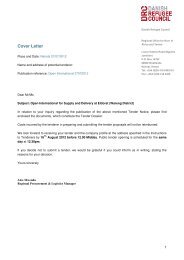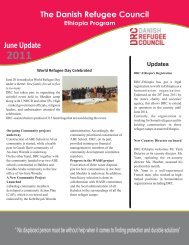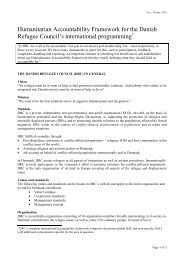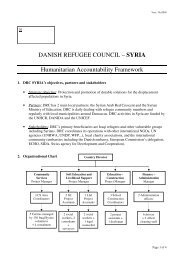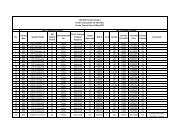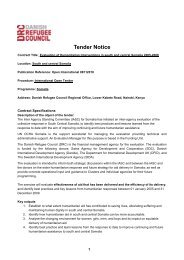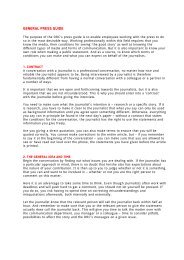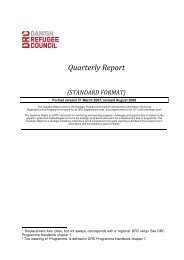Behind the Scenes, Kenya IDP Report - Danish Refugee Council
Behind the Scenes, Kenya IDP Report - Danish Refugee Council
Behind the Scenes, Kenya IDP Report - Danish Refugee Council
You also want an ePaper? Increase the reach of your titles
YUMPU automatically turns print PDFs into web optimized ePapers that Google loves.
Chapter 1: Introductioncannot be distinguished from <strong>the</strong> objectives andactivities of <strong>the</strong> advocacy sub-group of <strong>the</strong> PWGID.The strength of RCK as a partner in this sub-groupcould be ascribed to several factors, such as itsextensive experience in advocacy and policy development,most notably with <strong>the</strong> developmentof <strong>the</strong> <strong>Refugee</strong>s Act in 2006. Its programming forthat period had <strong>the</strong> technical and financial supportof <strong>the</strong> <strong>Danish</strong> <strong>Refugee</strong> <strong>Council</strong> Great Lakes CivilSociety Project and its approach and long standingrelationship with relevant stakeholders includingGovernment Ministries, civil society, UN bodiesand <strong>the</strong> <strong>IDP</strong> communities was close and constantenough to influence and garner support for certaininitiatives and thus lend legitimacy to its actionsand <strong>the</strong> process at large. For instance, RCK soughtto address issues emerging at <strong>the</strong> local level suchas <strong>the</strong> flawed profiling exercise by <strong>the</strong> Government.RCK worked with partners to develop an abridgedversion of, and o<strong>the</strong>r IEC materials, on <strong>the</strong> draftpolicy. The IEC materials were disseminatedthrough its training sessions on peacebuilding andreconciliation with peace committee members inUasin Gishu County and o<strong>the</strong>r training sessions forstate and non-state actors on <strong>the</strong> rights of refugeesand o<strong>the</strong>r forced migrants. RCK also engaged withformal and informal channels to maintain knowledgeon <strong>the</strong> process and intervene where possiblewith this advocacy expertise. For instance, RCKbenefited from <strong>the</strong> Executive Director’s previousengagements with <strong>the</strong> Minister of State for SpecialProgrammes (MoSSP) in <strong>the</strong> development of <strong>the</strong>Sexual Offences Act. 6 These established relationshipsand facilitated <strong>the</strong> organisation of high levelmeetings at short notice, helped <strong>the</strong> sub-group accesstimely information such as <strong>the</strong> status of <strong>the</strong>draft policy within <strong>the</strong> MoSSP and made it easierfor RCK to mobilise <strong>the</strong> relevant ministry staff toparticipate in <strong>the</strong> key workshops and meetings relatedto advocacy around <strong>the</strong> draft <strong>IDP</strong> Policy.In <strong>the</strong> same spirit, <strong>the</strong> MoSSP recognised <strong>the</strong> roleof RCK in <strong>the</strong> process of developing <strong>the</strong> policyframework and subsequently invited RCK to contributeto critical technical meetings that pushed<strong>the</strong> policy forward at different stages. Key meetingsincluded <strong>the</strong> first committee meeting of <strong>the</strong>Parliamentary Select Committee on <strong>the</strong> Resettlementof <strong>IDP</strong>s in Naivasha in February 2011, and <strong>the</strong>workshop between <strong>the</strong> MoSSP and <strong>the</strong> Ministry ofLand to build consensus around <strong>the</strong> provisions of<strong>the</strong> draft <strong>IDP</strong> Policy for both ministries in order toresubmit it to Cabinet in August 2012. RCK staffalso followed parliamentary proceedings duringtwo of <strong>the</strong> three readings of <strong>the</strong> <strong>IDP</strong> Bill in parliament.They regularly prepared briefing notes andshared with <strong>the</strong> advocacy sub-group to keep <strong>the</strong>minformed of progress of both <strong>the</strong> Policy and <strong>the</strong>Bill.1.5.4. Theoretical and ConceptualFrameworkIn this study and report, “policy” will be understoodin a very broad sense to include generalpolicy, specific policy, laws, institutions and governmentpractice. Unless o<strong>the</strong>rwise specified,<strong>the</strong>refore, reference to a policy framework includesreference to <strong>the</strong> Constitution, legislation,institutional set up and practices, whe<strong>the</strong>r in writtenform or not, existing in a single document orscattered across numerous sources, and whe<strong>the</strong>rimplemented in an ad hoc manner or sustainedand guided by some objective work-plans. It alsoincludes failure by <strong>the</strong> Government to take particularaction or courses of action (omission).In analysing <strong>the</strong> role of CSOs, this study greatlyrelied on a five-stage policy development cyclewhich covers setting <strong>the</strong> agenda for policy development;formulating <strong>the</strong> policy; adopting <strong>the</strong> policy;implementing <strong>the</strong> policy; and evaluating <strong>the</strong>policy. 7 By using <strong>the</strong> cycle, this report systemicallyassesses and re-examines <strong>the</strong> policy developmentprocess for ease of reference and adaptability forapplication in o<strong>the</strong>r contexts.The analysis in this report greatly benefited from<strong>the</strong> approach outlined in <strong>the</strong> Brookings Institution’smanual for law and policymakers especiallyin assessing <strong>the</strong> standard of protection offeredthrough policy interventions. 8 While seeking to establishbest practices that could be utilised beyond<strong>the</strong> national level, this study remained consciousof <strong>the</strong> primary obligation on <strong>the</strong> State to provideprotection and humanitarian assistance to internallydisplaced persons within <strong>the</strong>ir jurisdiction. 9At <strong>the</strong> heart of policymaking lies consensus-building,which is achieved through a consultative andparticipatory approach. This study views participationin policymaking as a continuum, with actorstaking part in <strong>the</strong> process to different extentsdepending on <strong>the</strong> surrounding circumstances and<strong>the</strong>ir inherent capabilities or disadvantages. As acontinuum, participation in policy encompassesa wide range of scenarios which may include: exchangeof information; public consultation andengagement; shared decisions and shared jurisdiction.Based on this, different actors would necessarilyengage with <strong>the</strong> policy development processto varying extents. This continuum was used to assess<strong>the</strong> extent to which stakeholders participatedin <strong>the</strong> process of developing <strong>the</strong> policy framework.1.5.5. Shortcomings of <strong>the</strong>MethodologyThe study encountered some methodological challenges.First, <strong>the</strong>re were several advancementsmade on <strong>the</strong> part of <strong>the</strong> Government towards <strong>the</strong>policy which were not properly documented. Thestudy would have benefited from engaging withmore Government stakeholders as key informantsthat could have shed light on <strong>the</strong> internal dynamicsthat affected <strong>the</strong> policy development process.This was not done on two accounts: first, becauseGovernment actors were scattered across numerousministries, sometimes with uncoordinated approaches,and second because of time constraints.For instance, while <strong>the</strong> PSC and its membersplayed an important role in <strong>the</strong> policy developmentprocess, it was not clear what <strong>the</strong>ir exact motivationwas nor what criteria were used to identify<strong>the</strong> original members of <strong>the</strong> committee.Secondly, though <strong>the</strong> interviews with <strong>the</strong> respondentstargeted persons and institutions that hadbeen significantly involved in <strong>the</strong> policy developmentprocess, at <strong>the</strong> time of <strong>the</strong> study some of<strong>the</strong>se respondents had moved to work with o<strong>the</strong>rorganisations or in o<strong>the</strong>r sectors. This affected tosome extent <strong>the</strong> respondents’ understanding of<strong>the</strong> two processes.Thirdly, as some persons interviewed had beeninvolved in <strong>the</strong> process of developing <strong>the</strong> policyframework, <strong>the</strong>re was a great risk of bias in <strong>the</strong>irassessment of <strong>the</strong> process. The study, however,greatly benefited from <strong>the</strong>se persons who had <strong>the</strong>institutional memory of <strong>the</strong> process and remainkey proponents of <strong>the</strong> process.4<strong>Behind</strong> <strong>the</strong> <strong>Scenes</strong> – Lessons Learnt from Developing a National Policy Framework on Internal Displacement in <strong>Kenya</strong> 5






